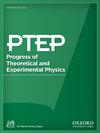雅各比-李模型和超引力方程
IF 8.3
4区 物理与天体物理
Q1 Physics and Astronomy
引用次数: 0
摘要
Poisson-Lie T-duality/plurality 最近被概括为 Jacobi-Lie T-plurality ,它是以双场理论(Double Field Theory)为基础、由结构系数 fabc、fcab 和 Za、Za 给定的莱布尼兹代数(Leibniz algebras)来表述的。我们研究了与 fbba ≠ 0, Za = 0 的六维莱布尼兹代数对应的三维和四维西格玛模型。我们证明这些代数彼此是复数,而且与 fbba = 0, Za = 0 的代数也是复数。有人猜想,复数模型应该满足广义超引力方程。我们发现了一些模型满足广义超引力方程的例子,而这些模型不可能微分到通常的超引力方程。另一方面,我们证明了还有一些模型对应于 fbba ≠ 0, Za = 0 的代数方程,其中广义超引力方程中出现的基林向量要么消失,要么可以通过适当的量规变换去除。这样的模型满足通常的超引力方程,即消失的贝塔函数方程。本文章由计算机程序翻译,如有差异,请以英文原文为准。
Jacobi–Lie Models and Supergravity Equations
Poisson–Lie T-duality/plurality was recently generalized to Jacobi–Lie T-plurality formulated in terms of Double Field Theory and based on Leibniz algebras given by structure coefficients fabc, fcab, and Za, Za. We investigate three- and four-dimensional sigma models corresponding to six-dimensional Leibniz algebras with fbba ≠ 0, Za = 0. We show that these algebras are plural one to another and, moreover, to an algebra with fbba = 0, Za = 0. These pluralities are used for construction of Jacobi–Lie models. It was conjectured that plural models should satisfy Generalized Supergravity Equations. We have found examples of models satisfy Generalized Supergravity Equations where no trivialization to usual Supergravity Equations is possible. On the other hand, we show that there are also models corresponding to algebras with fbba ≠ 0, Za = 0 where the Killing vector appearing in Generalized Supergravity Equations either vanishes or can be removed by suitable gauge transformation. Such models then satisfy usual Supergravity Equations, i.e. vanishing beta function equations.
求助全文
通过发布文献求助,成功后即可免费获取论文全文。
去求助
来源期刊

Progress of Theoretical and Experimental Physics
PHYSICS, MULTIDISCIPLINARY-PHYSICS, PARTICLES & FIELDS
CiteScore
12.00
自引率
5.70%
发文量
148
审稿时长
17 weeks
期刊介绍:
Progress of Theoretical and Experimental Physics (PTEP) is an international journal that publishes articles on theoretical and experimental physics. PTEP is a fully open access, online-only journal published by the Physical Society of Japan.
PTEP is the successor to Progress of Theoretical Physics (PTP), which terminated in December 2012 and merged into PTEP in January 2013.
PTP was founded in 1946 by Hideki Yukawa, the first Japanese Nobel Laureate. PTEP, the successor journal to PTP, has a broader scope than that of PTP covering both theoretical and experimental physics.
PTEP mainly covers areas including particles and fields, nuclear physics, astrophysics and cosmology, beam physics and instrumentation, and general and mathematical physics.
 求助内容:
求助内容: 应助结果提醒方式:
应助结果提醒方式:


